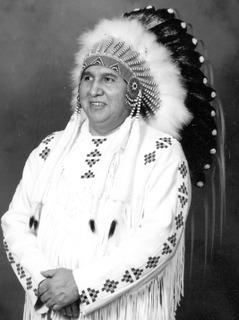Peguis First Nation facts for kids

Flag of Peguis First Nation, created by elder Freda Bear in 1983
|
|
| People | Saulteaux (Ojibway) and Cree |
|---|---|
| Treaty | Treaty 1 |
| Land | |
| Main reserve | Peguis 1B |
| Other reserve(s) |
Peguis 1C, 1D, 1E, 1F, 1G, 1H, 1I, and St. Peters Fishing Station 1A
|
| Population | |
| On reserve | 3,521 |
| Off reserve | 6,504 |
| Total population | 10,300 |
| Government | |
| Chief | Glenn Hudson |
| Tribal Council | |
| Interlake Reserves Tribal Council | |
The Peguis First Nation (once called St. Peter's Band) is the biggest First Nations community in Manitoba, Canada. It has about 10,300 members. About 3,521 people live on their reserve, and 6,504 live off the reserve. The people of Peguis are from the Saulteaux (Ojibway) and Cree groups.
Their main land, called Peguis 1B, is about 196 kilometres north of Winnipeg. This land is about 170 km northwest of their first home, which was called St. Peter's. They moved to their current spot in 1907 after an unfair land deal.
The First Nation is named after Peguis, a wise chief. He led his Saulteaux people from what is now Sault Ste. Marie, Ontario, to a Cree village in Manitoba. They first settled at Netley Creek and later moved near East Selkirk, Manitoba.
Contents
The Story of Peguis First Nation
Early Days and Treaties
Chief Peguis and his group settled north of today's Selkirk in the late 1700s. We know about their history from old writings. These include journals from the Hudson's Bay Company, records from the Lord Selkirk settlers, and notes from the Church Missionary Society.
In 1817, Chief Peguis and other leaders signed the Selkirk Treaty. This agreement gave land along the Red and Assiniboine Rivers to Lord Selkirk and his settlers. In return, the First Nation received tobacco every year.
On August 3, 1871, Chief Peguis' son, Mis-Koo-Kinew (also known as Henry Prince), signed Treaty 1. He signed it for the St. Peter's Band, which was the name of the Peguis First Nation back then. Treaty 1 promised 160 acres of land for every family of five people.
Land Claims Settlement
In 2008, the Peguis First Nation announced a big step forward. They reached a final agreement with the Canadian government about a land claim. This claim was about land near Selkirk that was given up in 1907. The settlement helped to right a past wrong.
Peguis First Nation Lands
The Peguis First Nation has ten different land areas, called reserves. These include 1075 Portage Ave in Winnipeg, Peguis 1B, Peguis 1C, Peguis 1D, Peguis 1E, Peguis 1F, Pegius 1G, Peguis 1H, Peguis 1I, and St. Peters Fishing Station 1A.
All together, these reserves cover a large area. They total about 30,657 hectares (or 75,755 acres) of land.
The biggest community is on the main reserve (1B). It is also called Peguis, Manitoba. This main reserve is next to the northern edge of the Rural Municipality of Fisher. Some other reserves are near Selkirk, East Selkirk, Libau, and in Winnipeg.
Media and Communication
The Peguis First Nation has its own First Nations community radio station. You can listen to it at CJFN-FM 102.7. This station helps keep the community connected and shares local news and culture.
Facing Floods
The Peguis First Nation has faced several floods over the years. These floods are caused by heavy rains and high water levels in the rivers.
Flood Challenges
In 2009, a big flood hit the area. Many people had to leave their homes for safety. Again in 2010, heavy rain caused more flooding. About 250 residents had to move, and many homes were damaged. Most people stayed in Winnipeg temporarily.
By 2011, the community was still dealing with flood damage. They worked to control mould in homes that were affected. The Peguis First Nation has been preparing for floods by building sandbags and working with government groups.
Preparing for the Future
To help protect the community, money has been invested in flood-proofing homes. In 2013, over $4 million was spent to make 75 homes safer from future floods. This helps the community be more ready for high water.
Amazing People from Peguis
Many talented people come from the Peguis First Nation. Here are a few:
- Marcia Anderson DeCouteau: A former leader of Indigenous doctors in Canada.
- Amy Clemons: She helped start the first Indian & Metis Friendship Centre in Canada. She also received the Order of Canada award.
- Trevor Greyeyes: A writer, journalist, and editor.
- Linden McCorrister: A hockey player for the Brandon Wheat Kings team.
- Cheryl McKenzie: A journalist for APTN.
- Renae Morriseau: An actress, storyteller, and director.
- Nile Expedition boatmen: Adam Cochrane, Alex Cochrane, Richard Henderson, John Pratt, Thomas Pratt, William Prince, George Settee. These men were part of a famous expedition.
- Shirley Olson: She helped start the Original Women's Network. She is also a lawyer and community activist.
- Tommy Prince: A brave soldier.
- William Prince: A popular singer-songwriter.
- Bill Shead: A former mayor of Selkirk, Manitoba.
- Murray Sinclair: A senator in the Canadian parliament. He led the Truth and Reconciliation Commission of Canada.
- Rosa Walker: She started the Indigenous Leadership Development Institute.
- Joshua Whitehead: A talented writer.
- Kona Williams: The first Indigenous Canadian forensic pathologist.


